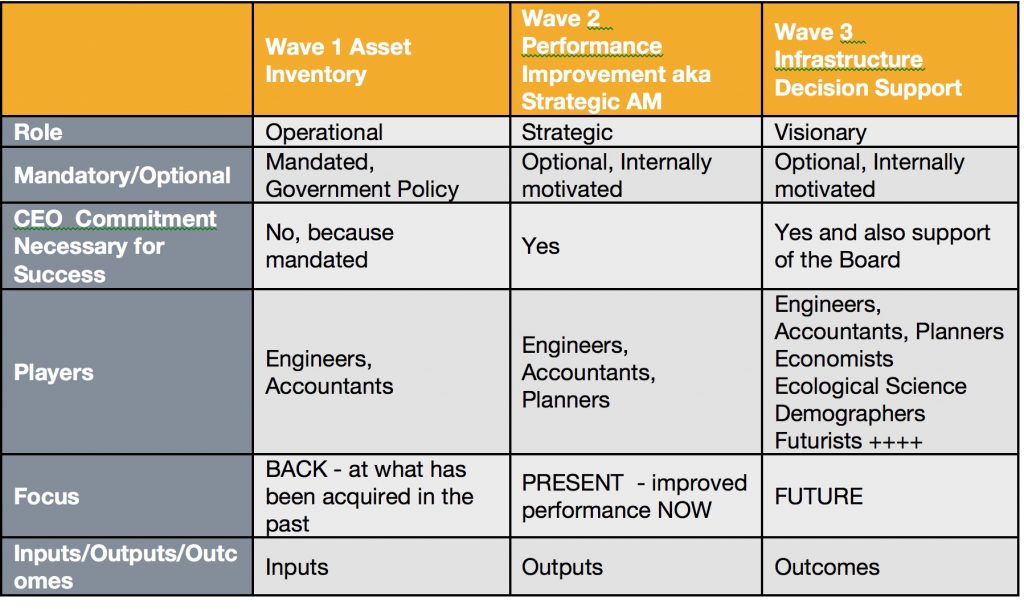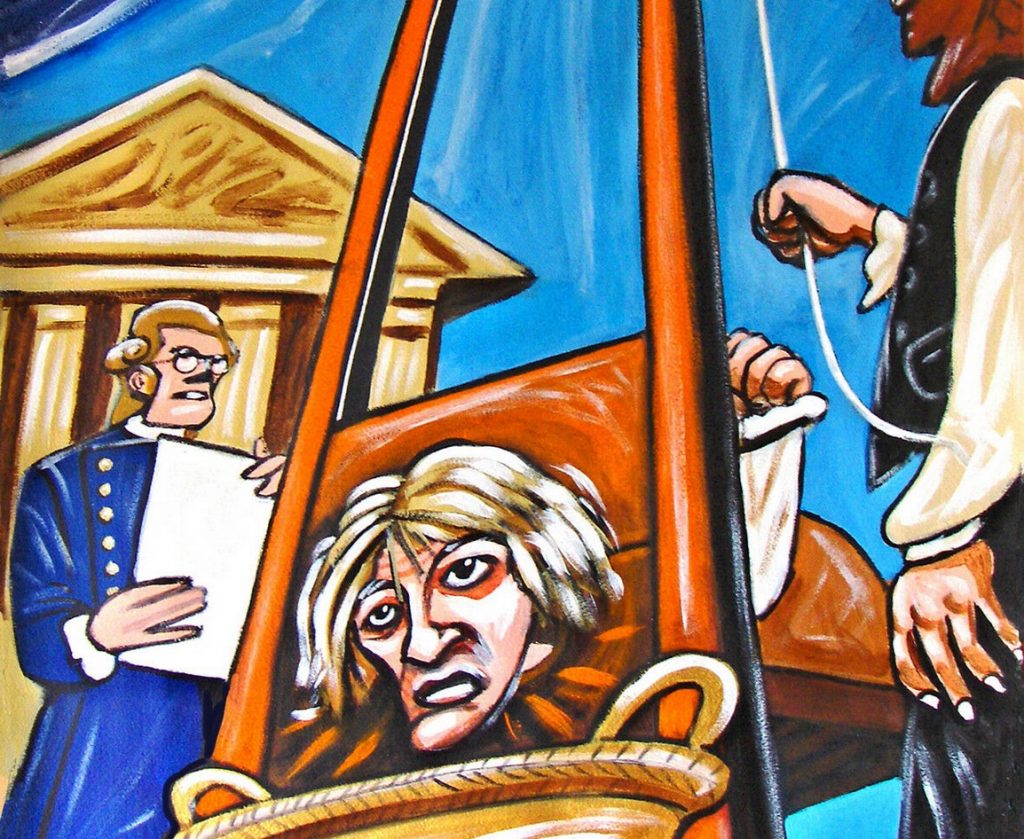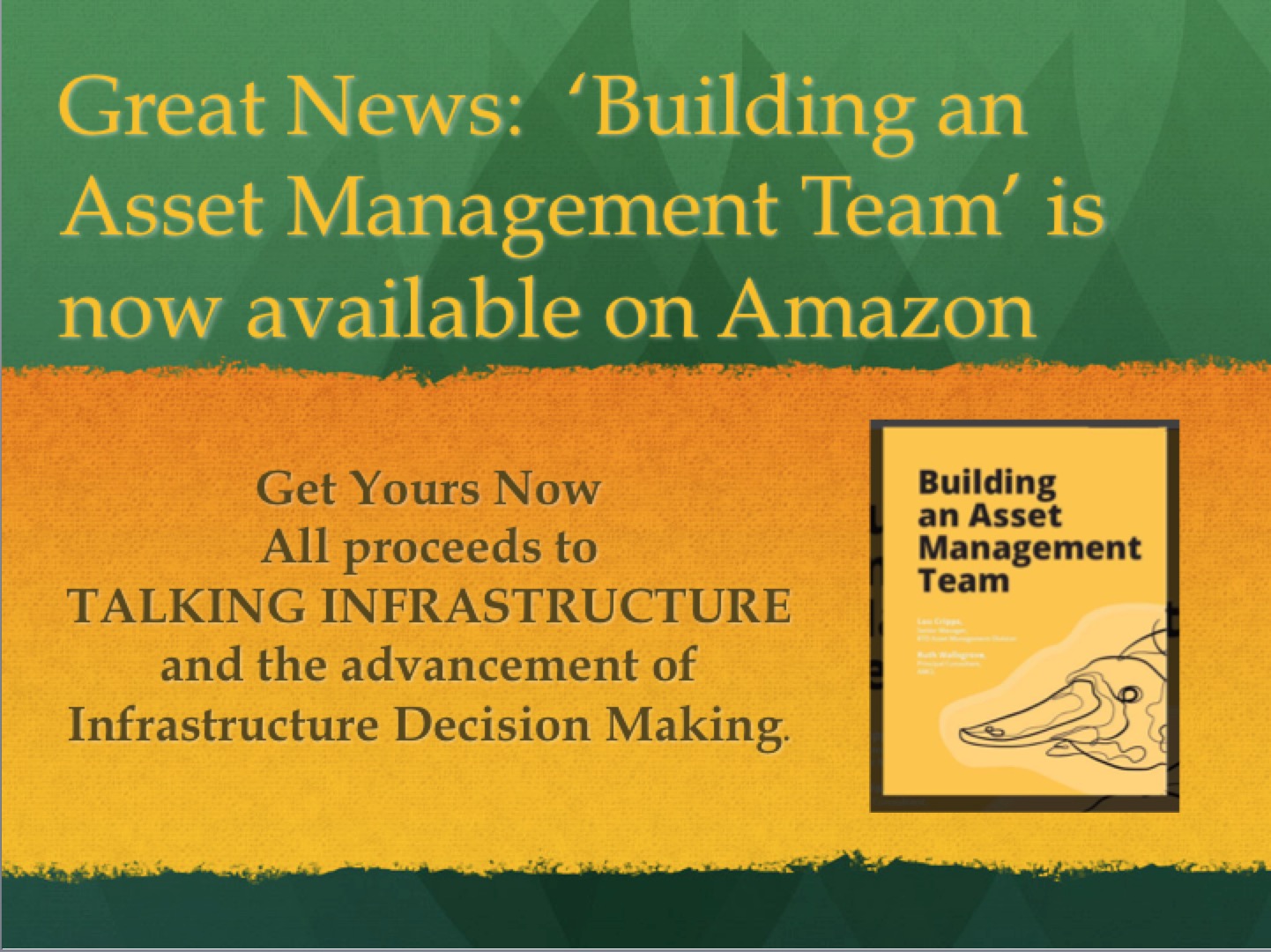
The wonderful ‘Big Picture’ animation from the Institute of Asset Management ends on a fascinating note:
Once we have optimised all our asset decisions to deliver our organisational goals – we can move on to asking about “the very reasons for the organisation’s existence”.
In part 2 of our audio series on the Waves of Asset Management, we explore alignment, a core principle of the Second Wave, or, Strategic Asset Management.
Hard as alignment is to achieve in practice – all those 1000s of asset decisions that have to add up in a co-ordinated, integrated way, now and into the future – it can raise an even bigger challenge for Asset Management practitioners. What are we aligning to?
What is the real purpose of my organisation?
And how can Asset Management help define it?
Part 2 of a discussion between Penny Burns, Ruth Wallsgrove, and Lou Cripps, in our new Thinking Infrastructure Aloud series – enjoy!
And let us know what you think!

Photograph by Andréa Farias Farias, Herdi no pedaço., CC BY-SA 2.0, https://commons.wikimedia.org/w/index.php?curid=83076806
In 2018 Penny Burns and Jeff Roorda suggested we describe our history in revolutions; a month ago, Penny proposed the history of Asset Management is more like Waves.
The First Wave of AM was to establish an asset inventory. We needed to know what we had to manage before we felt we could do anything else.
The Second Wave was to do something useful with this information: Strategic Asset Management, or better decisions to get a better answer in terms of cost, risk and performance. Of course, once we started actually using the data, we became much more aware of data quality and coverage. The need for good information didn’t go away. The best Asset Management practitioners are mostly still in Wave 2 – but already looking beyond it, for example in response to Covid-19.
The coming Third Wave is what Talking Infrastructure is all about. How to use what we have learned – all that data, sure, but more what’s involved in making better asset decisions – and look ‘up and out’ to the questions of what infrastructure our communities really need now, and into the uncertain future?
In March this year, after lockdown began, three of us – Penny Burns, Ruth Wallsgrove, and Lou Cripps of Denver Area transit agency RTD, across three continents – took the framework of the Three Waves and explored what this means to us in practice. Talking Infrastructure is happy here to deliver Part 1 of the recording, the first in an on-going series called Thinking Infrastructure Aloud that we intend not merely as audio downloads but public podcasts.
You get to be the pilot for this, and so: it is even more vital that you comment, and give us feedback on our move into sound!
1. How do our experiences match your own?
2. How to ride these Waves into the future?
3. And do you like this audio?
NOTE: Part 2 of The Waves Podcasts is also now available at www.TalkingInfrastructure.com

Homo Sapiens is a pattern seeking species
it is how we advance. We seek patterns to find meaning. Me, I look for patterns in AM development. I seek the characteristics of the different stages (that I now think of as waves rather than as revolutions, as explained in the last post) and how each builds on the one before and takes us further. This helps me to see not only where we have been but also where we can go. Each wave has its own focus, viewpoint, key players and sources of support as well as constraints. Below is a table illustrating some of the characteristics of the first three waves that I see. What do you think?

Where we have been and where we are
Waves 1 and 2 you will readily recognise, for they reflect where we have been and where we are. Wave 3 is where we need to go next. This is the visioning stage where asset management teams, use their appreciation of ‘line of sight’ or the necessity for asset actions to support organisational objectives to guide decisions on both new and existing infrastructure. This is where AM teams need to anticipate, communicate, and prepare for the inevitable shifts in attitudes, governance and demand, that are now occurring and will continue to occur as demographics, climate and technology change. Turning around large infrastructure portfolios is not an overnight task. It takes intelligent planning and communication. This is Wave 3.
Where we are going
Communication, anticipation, action. In Wave 3 AM teams help their corporate managements to explicitly recognise that the asset portfolios and management practices they have now are a reflection of the past, and that the future will be very different from the past and will involve new thinking. This may seem obvious, but it is not necessarily happening at the moment. Sometimes it seems that it is easier to assume that nothing will change very quickly so we can continue doing what we have always done. And sometimes the lure of the new and shiny leads to adoption of the new without sufficient examination.
The Wave 3 challenge is not to jump straight into the new and exciting, but rather to determine how best to reduce the twin dangers of changing too early, and of moving too late.
The biggest change will require us to ask what changing circumstances and future communities will DEMAND of us, what the new needs will be, and not to look at new technology as merely an opportunity to change the way we SUPPLY the current needs of our customers and community.
From Supply to Demand. In the past most of the information we have needed for our decision making in asset management has been internally generated and recorded in our Asset Information Systems. This has been solely supply side information. We still need our supply side information. But this will not suffice. Knowing what we CAN do is not enough. We need also to look at what we MUST do. For this, we will increasingly require the ability to understand and anticipate future demand change. This is why our our asset management teams will need to expand to include the talents of many other professionals, as I have suggested in the table above.
Is your Asset Management Team prepared?
Is your Asset Management team prepared to tackle the third wave? If you are not sure, then a good place to start would be with “Building an Asset Management Team” by Ruth Wallsgrove and Lou Cripps. This will help you recognise not only requirements but also the many new possibilities. Here is a short excerpt “What kind of people does an AM team require?”
Note: When you buy “Building an Asset Management Team” you not only get the very latest thinking in AM teamwork, but you pave the way for future developments, for Ruth and Lou are donating all their proceeds (ALL, not just profits) to Talking Infrastructure.
So go ahead, click this link to get your copy. You can get a Kindle version for less than $10. In this case value greatly exceeds cost. It’s priced low to maximise the number of teams that can gain access. Spread the word!

I was wrong. Movement from maintenance to asset management, to strategic asset management is NOT a revolution. Why not?
In 2018, for the IPWEA’s online journal, Jeff Roorda and I sketched out what we saw as the general pattern of these individual journeys and what this suggested about where we would go next. At the time there was a lot of discussion about the third (and for some) the fourth industrial revolution. We needed a sexy title for our paper so we called it ‘The third AM Revolution’.
We saw AM moving from the pre-AM stage of maintenance only to the first stage of data collection, or ‘asset inventory’, to the second stage of performance and alignment, or what we call ’Strategic asset management’ – the stage we believe most of Australia is now in – to a new third stage, our ‘third revolution’ that we are calling ‘infrastructure decision support’.
We now see that ‘revolution’ was the wrong word.
Revolutions have connotations of what was previously important getting the chop – quite literally in the French Revolution! Although each of the three stages we identified are still important because they represent different mindsets and approaches, different groups of players and different techniques, they do not discard what went before. Instead they increase our understanding of their value and make them stronger.
Let’s see how that works.
0. Before AM there was maintenance. Maintenance specialists firmly believed in the value of their work, and they were right. Unfortunately they were unable to convince others, especially finance. When AM came along it provided a framework to demonstrate that not only was maintenance able to fix what was currently broken – it could also help prevent more breaking down in the future. That is why so many maintenance engineers were keen to see AM adopted by their organisations.
1. The first stage of AM, naturally, was to establish an asset inventory. We needed to know what we had to manage.
2. With enough basic data we were enabled to take the next step use the data collected for performance improvement. When we did this, we became much more aware of data quality and coverage. That first stage of data collection did not get the chop, now we wanted more. Instead of data being required simply for a mandated balance sheet (e.g. a storage location) it was increasingly seen as necessary, indeed essential for progress, and so demand for more data, and for data of a higher quality with greater coverage has continued.
3. The coming third stage is what will bring all of these stages – maintenance, data collection and performance improvement or strategic asset management – together, for it is at this third stage that asset managers finally reach the stage that they have desired for a long time. Asset management is able to get (and worth a) place at the board table!
So not a revolution. But what?
We could simply call them ‘three stages’ and be done with it. This, however, would not show the connection between them, how each builds on what went previously, so we are calling them waves, for like waves they build on each other and get stronger.
Why is this important?
Because now that it is so easy to access detailed information about the second wave of strategic asset management or performance improvement (IIMM, PAS55, ISO 55,000) there is a temptation is to dive in at this level. But without attention to the first wave of data collection and without strengthening the pre-AM stage of maintenance, such attempts lead to failure. Under-developed countries wanting, and needing, to do fast catch up with the developed world are at particular risk.
They are being pressured ‘to do asset management’ in order to get the strategic asset management, second wave, benefits but the importance of funding and training at the earlier stages, particularly maintenance is not being recognised and dealt with. Every stage – maintenance/pre-AM, data collection/asset inventory, and strategic asset management/performance improvement or alignment – requires a different focus, different tools, different groups of players.
I will talk about Wave 3 – where we go next – in a later post.
Q: Does this development pattern make sense to you?
Can you recognise it in your own organisation or others? Is it obvious, or do you see an alternative pattern to your own asset management journey?
Coming Next: The Three Waves
Why understanding them can help you move closer to your ultimate goal.

Ten years ago, on LinkedIn’s Asset Management History Forum, I asked “Why bother with history?” It was the most animated discussion on the forum. Now, with ten more years of history behind us, have we learnt more or do you agree with Jan Korek’s view that history is irrelevant?
This was Jan Korek’s opening statement:
“I have never subscribed to the suggestion that you need to know where you’ve been, to know where you’re going! History, to me, is little more than a badly-drawn representation of the past, based on an exaggerated impression of successes….. and an amnesia of the failures.
Having been deeply fascinated by Asset Management for a score or more years, and am still working at the blunt edge of the process, I have had to change, adapt, forget much and learn more along the way. So what do practitioners, or the process, gain from a knowledge of when (or why) some obscure government department became notionally interested in the stewardship of infrastructure assets? I would suggest very little.
Anyone who has been in Asset Management for a period of time will have grown their own unique history based on any number of influences. So what is to be achieved in distilling each individual story into an homogenised, badly-drawn fiction? Experience shows that we even fail to avoid the mistakes of the past, even when we know the history involved. The news, each day, is full of such examples.
What seems more important is the future, “Where are we now”, and “Where to from here”? Or to put it another way, you need to know where you are now, to know where your going.”
A compelling set of arguments.
Opening for the other side was John Hardwick.
Wow!
What a start to the year you go away for a couple of days and a great discussion begins. I can only say that everything i have implemented has come from others.
I have implemented knowing what worked and what didn’t. I have used this to significantly change the way my organisation does Asset Management. I am only new in comparison to many of you but it is your collective knowledge i have used.
Also I have used your history and stories that have helped many other companies not make the same mistakes. I am a strong believer that we learn from our mistakes and not to make them again.
If this is the case it is critical for new organisations implementing Asset Management to have access to some of the good the bad and the failures.
I have given more then 20 organisations access to my staff and myself over the last twelve months to learn from what we have done and the mistakes we made. The best part is I learnt so much in return it has been amazing.
History allows us to tell stories that help others conceptualise their path to hopefully a more successful future.
Also a compelling set of arguments.
What’s your view?
How has your understanding of AM history enabled you to be a better asset manager?

We are about supporting AM Leaders!
Here’s the situation we face:
We are moving into a “perfect storm” where our natural and built assets move into states of uncertainty and instability. We must rapidly build an understanding of the integration between our ecology and built infrastructure because rapid changes will increasingly challenge or capacity to foresee and manage risks. We are already seeing the initial evidence or these risks in major fire and flood events and likely pandemic events.
Growth boom infrastructure is approaching end of life, ageing population requires infrastructure realignment, climate, environment and virus risk changes start to move from debated possibility to clear and present dangers. Technology is the wild card with the potential to provide new solutions or exacerbate existing problems. Where we allocate our resources is more important than ever before.
The decisions made by this generation will determine the quality of life of future generations. A future that could be bleak and fearful or exciting, prosperous and filled with hope. Our current decision-making framework and decision support processes, systems and assumptions need rapid overhaul to support our current leaders guide us to the future we want and the following generations deserve. We can avoid reacting to preventable or manageable disasters by developing integrated rather than fragmented strategic plans.
What do we want for our future?
Talking Infrastructure’s Vision is a world in which decision makers understand and care about the cumulative consequences of their decisions and their constituencies understand the trade-offs involved in those decisions.
What do we have to stop doing?
We need to stop thinking of ‘infrastructure’ as a panacea for all economic ills, but rather to consider individual infrastructure projects and their individual contributions to general wellbeing – economic, social, and environmental. What questions do we need to ask of all projects to make sure that we are ‘future friendly’? What do we need to know about the relationship between future change and infrastructure? What changes do we need to make to current decision processes to achieve this goal? Could these resources be better allocated to prepare for future foreseeable risks.
We want to avoid infrastructure waste. Stranded assets are assets that are now obsolete or non-performing and recorded in corporate books as a loss of profit. Current estimates vary but run into the many trillions of dollars. Climate, technological and demographic changes all contribute to this problem. But so do we – when we construct infrastructure better suited for the 20th than the 21st century. Every year we use up valuable resources and add to environmental damage and often social damage, constructing long-living assets destined to end on the stranded assets scrap pile. Resources that could be used to mitigate more urgent foreseeable risks.
We believe we can do better
In the past, governments have tended to see infrastructure as an expenditure ‘blob’ – useful for soaking up unused corporate savings to ‘kickstart’ the economy or as a generic ‘source of jobs’. These are the attitudes that have got us where we are now. We believe that if we focus on ‘future friendly’ projects, that takes future change into account and specifically designs for it, we can avoid unnecessary waste and manage future risks.
This requires us not to think of ‘infrastructure’ as a panacea for all economic ills, but rather to consider individual projects and their individual contributions to general wellbeing – economic, social, and environmental. What questions do we need to ask of all projects to make sure that we are ‘future friendly’? What do we need to know about the relationship between future change and infrastructure? What changes do we need to make to current decision processes to achieve this goal?
This is what Talking Infrastructure is about!
Do you also believe we can do better?
JOIN TALKING INFRASTRUCTURE
to keep up with latest thinking and doing and join us in our work towards wiser infrastructure decision making,
go to top of the right hand column.
It’s free and you will be part of a growing number of professionals from all disciplines: planners, strategic asset managers, financial specialists, environmental scientists, economists, sociologists, administrators and many others who share the realisation that to really benefit from the many changes that now surround us, all decisions need to undertand the past, act in the present ,and be open to the futures now emerging, so
Get Involved! Members receive our monthly newsletter containing brief synopses of what we have posted during the month and opportunities for you to share your knowledge and ideas with others.

The Scene
It was twenty years ago and I was in the office of a regional council CEO. I led with an open question “How important do you think that AM is?” He was a nice fellow, he didn’t want to hurt my feelings but clearly he was not enthusiastic about the subject. “I guess it is valuable, but we aren’t going to do it!” “OK” I said, curious, “Why not?” “Well, look it’s this way, if that section of Carter’s road gets washed out in the next flood, that is where I am going to have to put my money, not into some future renewal fund!” “Entirely right”, I replied. “That will be your first priority. Can asset management do anything to help avoid that flooding problem? Can it, at a minimum, reduce your overall asset maintenance expenses to free up the funds you need?” It was clear that he had not seen asset management in this light, that is as a solution. He had equated AM with a renewal forecast, a problem. And too many still do that – CEOs and Asset Managers both!
The Story
There was the Asset Manager who presented his renewal forecast to the board and told them that they would have to double their asset expenditures. The board sacked him. And they were right to do so! That fellow was not doing his job. He was simply stating the problem and expecting others to take action so that he would not have to.
The Point
A future renewal forecast is not the end point of an Asset Manager’s task – it is the beginning. It states the problem, as accurately as can be done. But it is still only the problem. Now a solution has to be found. The task of the asset manager is to find that solution. Not to be like a certain US President who expects to be praised for doing nothing to solve the problem whilst making it worse. Indeed by not immediately taking action to find a solution that Asset Manager was making the renewal problem worse.
The Future?
Asset managers often ask how they can sell asset management to the board or senior executives. The answer is obvious (although not necessarily easy): it is to tell them how AM can solve their problems. The first step is to find out what their (not your) problems are. What do their customers, their clients, their regulators want of them? Most often when I ask asset managers what are their organisation’s key issues, they answer in terms of their own issues instead. At asset management conferences I hear people claim they want to make their organisation an outstanding asset management organisation. That is OK but it is not why your organisation is in business!
Lou Cripps, co-author with Ruth Wallsgrove of ‘Building an Asset Management Team’ ( highly recommended and available from the Talking Infrastructure website) summed it up this way.
“For too long we have been looking down and inwards. Now we need to look up and out”.

Photo by Сергей Гладкий from Pexels
A single source of truth
As digital transformation expands, there has been pressure in the field of asset management to consolidate, structure, reformat and create new data and align it with the business processes to create a systems approach for informed decision making, with the aim of providing structured data that can become a single source of truth for organisations and enable quality decision making for delivering value to the end user. Many providers of Asset Information Systems and IT promote this as their goal.
Logically, can there be a single source of truth?
While I am definitely in favour of IT solutions (#More code, less cement), I am struck by that phrase “a single source of truth” and ask myself ‘is aiming for it missing the point?’ We have, for a long time, argued that good decision-making requires good evidence. But good decision-making, as we are coming to recognise in these difficult times, is multi-layered and this means that the evidence needed for these decisions must also be multi-layered. No matter how clever our IT, we cannot rely simply on the information we can generate within our organisations, but we need to look without and beyond.
Consider what we have now learned from Covid 19
As the world has watched – and felt – the impact of Covid 19 in recent weeks, we have developed a new respect for Experts and the data, analysis and evidence that they can provide to help us feel our way through this problem. I say ‘feel’ advisedly. Because we are like the blind here, and will need to zig-zag our way forward, trying something and then retreating if the infection rate rises.
First there was a infection pandemic – a health problem. Here in Australia we responded with a national lock down that has been hugely effective in curbing the rate of new infections and thus deaths. But now we have an economic problem as 1.7 million are thrown into unemployment and factories, wholesalers and retailers are standing idle and interstate and international travel and thus tourism halted.
The government has sought to ease the impact on unemployment with its job keeper and job seeker allowances and this has been sound thinking. But later it will need to decide what to do with the debt it has incurred – a public finance problem. No-one knows how long the support will last or when they can go back to work. Many, particularly the most vulnerable casual workers, are not covered. Anxiety rises. Authorities are now anticipating serious mental health problems and a rise in domestic violence.
Sporting events have been cancelled and resumption of them is a major talking point in the media for all of us who would normally attend the football on the Saturday and yell and scream for our teams, (and discuss it endlessly on Thursday, Friday and Sunday) no longer have this opportunity to break tensions, relax and cement social relationships. The arts are particularly affected as few arts workers fall within the protected jobs range. What are we without the arts, without sports?
Yes economics is important. But it is not the only thing that is important.To solve a multi-layered problem it is not possible to have ‘ a single source of truth’
Now let us return to Asset Management.
Is it possible to make decisions based only on clever IT applied to our assets? That may enable us to determine our internal supply costs – but outside in the world how do we know how much will be demanded? What external costs – and benefits – will our actions create? What impact are we having on the mental health of our workers and on the environment? We may be able to make a profit in the short run but what of our resilience in the face of change in the slightly longer term?
Asset decisions are thus also multi-layered, so can Asset Managers really expect that in serving all their stakeholders they can rely on data for ‘a single source of truth’ – no matter how cleverly calculated? Or do we have to come to terms with the fact that all of life is a trade-off? And thus consider how we learn to deal with trade-offs?
If not a single source of truth, then what?
An important question! Talking Infrastructurebelieves that more is required of AM Leads than simply to follow an IT algorithm or a one point source of information. We need to be able to think through the ‘cumulative consequences’ of our decisions, and to that end we are developing “The toolkit for Leads” specifically for those who head up our asset management teams (or aspire to) and see themselves as being a more forward thinking and active part of their organisation’s decision making.
If you would like to know more, sign up now to be a member of Talking Infrastructure (it’s free) and we will advise you as soon as it comes online and keep you up to date with additions.

We all admire the excellence of precision teams like the Red Arrows, the RAF Aerobatics team. Sheer magic! But, believe it or not, your job in building an asset management team is harder! This is the fifth and last excerpt of “Building an Asset Management Team” by Ruth Wallsgrove and Lou Cripps. Sorry about that! But you can now get the whole thing from AMAZON. No Asset Management team should lead without it!
Five: What is required of the AM lead?
AM is as much a business and communication function
as a technical one in practice.
Whoever you select to run the AM team, they must have:
1. Some good team management skills – or be actively developed in these
2. Communication skills to communicate and co-ordinate both upwards to senior leadership and external stakeholders (for example Boards for public agencies and other politicians), with delivery functions, particularly closely with Maintenance, and with key support functions such as Finance, Procurement, and IT. They have to take the main responsibility for buying the organization into good practice AM processes.
3. The ability to inspire the actions of others towards a common aim. Not only is AM about alignment to shared targets, it’s also hard to implement, and so needs people who are inspired.
4. Understanding of the importance of good business processes themselves!
We would also include be willing to be wrong, and continue to move forward.
It should go without saying that they need to understand Asset Management, and at a minimum this means they have been through some training. Recruiting someone from another organization who has already done AM is of course a great idea – if you can find them. Demand wildly outstrips supply of experienced AM practitioners in North America, and indeed elsewhere.
Who is selected sets the tone and will need to lead the effort
up and down the organization.
Lou: they must be a leader and not just a manager. This will include knowing the direction to take the team and the abilities to get others to want to help get there. They protect and care for the individuals, the team and believe in the cause themselves.
The lead is not required to be the technical expert: they have to be okay with surrounding themselves with experts who know more than they do.
!Warning!
You are building Asset Management practitioners and leads for others!
If you build a good team, there is one thing you need to prepare for: that they will get head-hunted away by other agencies looking for someone with real Asset Management experience. This just happened to RTD’s AM Division.
Both of us find this personally painful – we tend to love our teams and the good people in them – but of course it is part of developing good AM more widely. It’s probably wise to assume that, since some of them will move, it’s worth encouraging them in good management and leadership skills all along. And you have to want the best for the individuals on your team, otherwise you won’t be a good lead yourself.
Some thoughts on AM team culture from Lou
I am extremely fortunate to work with great people.
But a good team isn’t just a collection of good people, although that is a huge part. To build the right team, we need to be clear on what the team would do, and what ‘we’ wouldn’t do. How will we work together to achieve collective goals: team culture.
Essentially, we need to do this through a Plan-Do-Check-Act approach:
•Clarity about the enabling attitudes – a vision of the target culture, and a clear sense of what the culture is at the moment and how it falls short of what’s needed
•Communicating and encouraging these in different ways to reach different groups
•Actively look for ways to measure and monitor this change
•Review and adjust change strategy from lessons learnt
We have to create the right environment, where it is ‘safe to explore’: creating enough safety for people to be happy to go out in to the new, the unknown. There are some rules, and the leader will play a fair referee on them.
Asset Management is not the only area in our society that can have challenges with experts. We don’t mean that we need less expertise, or should not listen to people who know more than we do. But an increasing amount of research suggests that people who identify as experts come with their own blind spots; and that being smart and well educated, and knowing it, can make for worse, not better decisions.
The real issue is assuming you know more than you do – lacking humility about what you don’t know, and believing that what you know is enough. ‘To the man with a hammer, every problem is a nail.’
In the world of asset decisions, no one person ever knows enough.

This book should be in every AM office, and at less than $9.99 it won’t even make a dent in your budget. So do it! Here is the Amazon link. Need more encouragement? Then read our 4th excerpt and find out who to have in your team.
Four: What kind of people does an AM team require?
Considering what is required – and the world now has nearly 30 years’ experience of what it takes to make Asset Management work, starting in Australasia and from the late 1990s in Europe – it is not surprising that dedicated AM roles do not suit everyone, and many organizations have made some mistakes in their AM appointments.
It is also true that the different requirements of a well-rounded AM team will always make it unlikely, even undesirable perhaps, that one individual would hold all the necessary skills and experience. Instead, we need each team member to have confidence in their own strengths and complement each other towards a common purpose – very much like the ideal Asset Management organization writ large.
Any AM team requires a balance of people.
- Asset Management is a bridge between business strategy and technical delivery, and therefore must consider the right balance of attributes and skills to deliver this.Bluntly, an Asset Management team that is purely technical, or alternatively has no experience with assets, will struggle. Some experience in the team on front line delivery and, even better, existing relationships with the front line, especially maintenance, is invaluable, but AM also needs good analysis skills and business understanding.
- More challenging for some technical people is the need for good communication skills. Since AM implementation is hugely about communicating what AM is about and facilitating the improvements, AM practitioners must at least value communicating.
- AM functions have to see themselves as promoting, influencing and coordinating rather than directly delivering. (Wally Wells of Asset Management British Columbia calls this the folded arms approach.) This means developing good relationships with a range of other teams. AM practitioners have to be able to acknowledge and respect what other people know, and have some detachment, because their role is to bring together different teams and types of experience & knowledge into asset strategies and integrated planning, not to try to impose their own opinions on asset decisions. They must have a big picture view of the business such that they understand concerns within silos but can explain the needs of the entire organization to put the concerns into context.
- Another specific requirement is for people who can ‘embrace uncertainty’, since AM is at its heart about planning for the future – and the future is always uncertain. For example, ProGas in the Netherlands in the early 2000s focused on promoting smart technical people into asset planning: the only ones who succeeded were those who could cope with making decisions on clearly imperfect knowledge and data. Many could not.
When Penny Burns took the RailCorp Strategic Asset Management team managers through Scenario Planning training, the most important outcomes were making everyone feel a little less certain about the future for the railway – and set us to thinking hard about what data would indicate a real trend.
- The ability to think probabilistically is not intuitive, but it is of great value and can be learned. Those that have developed their understanding of probabilities can use this thinking to help address the uncertainty that is essential to describing systems, predicting outcomes, and influencing outcomes.
- A structured approach to problem solving, even to questions where there isn’t an obvious right answer, or the exact answer can’t be known, is important. AM practitioners should be curious and ask questions, working to discover root causes.
The strongest AM practitioners seem to know when there isn’t a single correct answer, and what set of constraints should be used to move forward with the next best alternative.
An Asset Manager has to be comfortable saying, “I don’t know.”
- It’s also vital to be able to see what is important, the AM principle of criticality, and the balance of ‘cost, risk and performance’ in what we do ourselves.
- AM implementation is about change, so generally will not suit anyone who primarily seeks stability or following the old rules. We need people who have some social skills and ability to build good working relationships, at the same time that they will push for change, in other words stand up for new ways of working.
- Continual improvement requires a desire to learn new concepts and ideas, even when the evidence overturns what you expect. Continual improvement requires a place of pause and reflection before the next Plan-Do-Check-Act cycle is commenced.
- Leadership skills to get others to buy into our new ways of thinking and working.
And the ability to balance the natural tensions that exist between all of these skills….
This is hopefully not to completely depend on unicorns – or platypuses – that we may never find.

We are looking for an odd and tricky combination of attributes. Instead of searching for a very rare and sought after amphibious, duck-billed, otter-footed, egg-laying, beaver-tailed, venomous mammal that locates pray through electroreception – it’s easier to provide all the things we need through a complementary team.
It is also important to understand what skills we don’t need because they exist in other areas and within the asset class groups. We don’t need to be experts in all areas if we can coordinate with others.
RTD’s AM Division looks for these attributes in everyone it hires:
- Highest ethics and integrity
- Cognitive ability
- Objectivity and self-awareness
- Basic numeracy
- Effectiveness
- Curiosity / lifelong learner
- Problem solving
- Humility
- Initiative / motivation and grit
A good sense of humor also helps.

Recent Comments